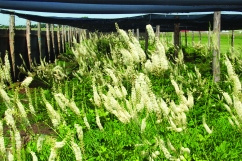Black Cohosh
Developing Nut, Fruit, and Herb Production for Midwestern Farmers through Agroforestry: Black Cohosh
Principal Investigator: Andrew Thomas
Study Site: University of Missouri, Southwest Research Center, Mt. Vernon, Mo.
Medicinal herbs hold significant potential as profit sources for Missouri landowners pursuing production through the agroforestry practices of forest farming or alley cropping. Ginseng, goldenseal or black cohosh, for example, can be planted in between tightly-spaced rows of pecan or black walnut trees in an alley cropping practice, where a shade overstory is present, or established within a wooded area as a forest farming practice.
Black Cohosh: A Native Medicinal Herb in Great Demand
One of the nation's most significant research programs on the cultivation of
potential agroforestry crops is based at the University of Missouri's Southwest
Research Center, Mt. Vernon, MO. Located in the Ozarks region of the state,
this 900-acre research farm is an ideal setting for the cultivation and study of
a wide variety of tree and crop plants appropriate to agroforestry.

|
The herb black cohosh (Actaea racemosa) is found naturally in the Ozark and Appalachian regions of the USA, and has been used medicinally by Native Americans for centuries. Its roots and rhizomes are now commonly sold in health food stores for treatment of menopausal symptoms. "Black cohosh is presently among the top ten medicinal herbs grown and used in North America and Europe. The species is being significantly over-harvested from its natural range, which is causing serious concern," said Thomas. "We're one of the few institutions studying the cultivation of this plant in an effort to increase profit potential for producers while reducing harvest pressures on declining native populations." Nearly all black cohosh is harvested from the wild in the U.S., with very little in cultivation. Currently 95% of the black cohosh harvested is exported to Europe, where it is prescribed by doctors.
Black cohosh has been clinically proven to relieve menopausal symptoms, such as hot flashes, in some women. Such positive clinical results, combined with concerns about possible serious side effects of hormone replacement therapies, have fueled great interest and demand for black cohosh products. But cultivating black cohosh is a long-term undertaking, as plants must be 3 to 5 years old before their rhizomes are large enough to harvest. And then, once they are of age, the entire plant is destructively harvested. One of the experiments at the Southwest Center is exploring the possibility of harvesting targeted medicinal compounds from tissues such as leaves and flowers. "Our research indicates that there is two to three times the amount of certain medicinal compounds in the leaf, and 10 times the amount in flowers compared with rhizomes," said Thomas. "The possibility exists to establish annual harvests of various renewable plant tissues (such as leaves, stems, flowers) for specific medicinal compounds, rather than destructively harvesting the entire plant only once after 3 to 5 years. This type of focused research, combined with numerous cultivation studies, places UMCA at the forefront of medical herb studies."
Key Findings, Black Cohosh:
- Proper site selection, including well-drained soils, is essential.
- Generally easy to grow in Missouri; can be produced in shadehouse or forest.
- Numerous pathogenic organisms are capable of attacking black cohosh if the conditions are suitable.
- The disease "black root and crown rot of black cohosh" is associated with 3 species of Phytophthora, 6 species of Pythium, 1 species of Rhizoctonia, and at least 1 species of Fusarium.
Sources:
Abad, Z.G., J. Phillips, and A.L. Thomas. 2005. Black root and crown rot of black cohosh (Actaea racemosa L.) is associated to Phytophthora and Pythium species. Phytopathology 95:S1. (Abstract)
Thomas, A.L., R.J. Crawford, Jr., L.J. Havermann, W.L. Applequist, B.E. Schweitzer, S. Woodbury, and J.S. Miller. 2006. Effect of Planting Depth, Planting Season, and Fungicide Treatment on Establishment of Black Cohosh in a Poorly-drained Soil. HortScience 41(2):374-376.

